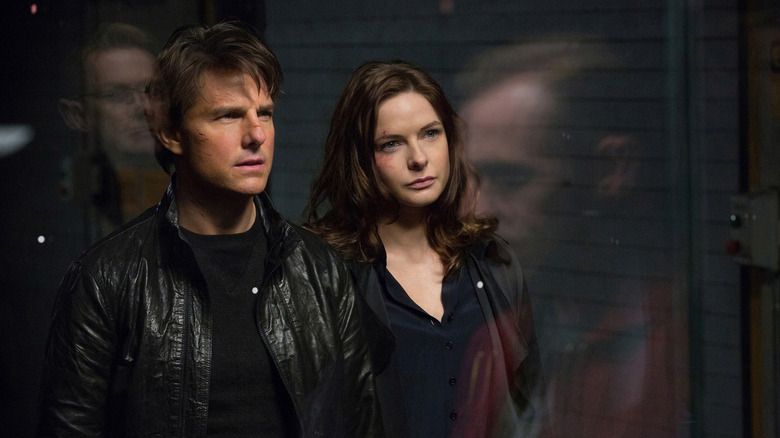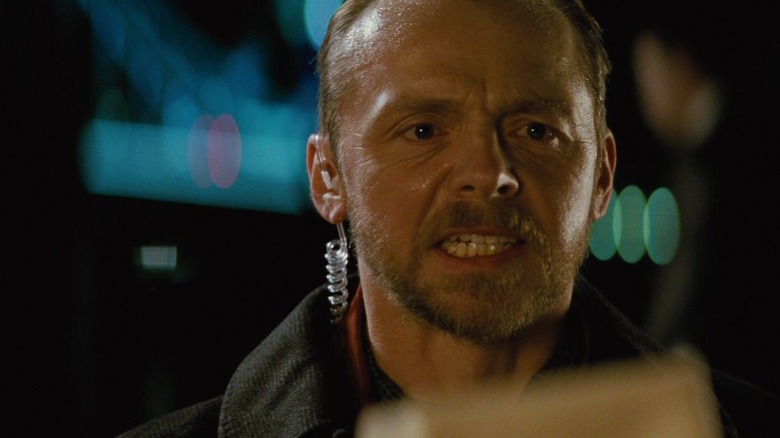Tom Cruise Saved Mission: Impossible Rogue Nation's Ending With A Smart Change
Christopher McQuarrie's 2015 action blockbuster "Mission: Impossible – Rogue Nation" — the fifth film in the series, and handily its best — has an unexpectedly inverted action movie structure. It begins with the film's biggest, most impressive stunt, and ends with characters merely sitting around a table, discussing how they are to defuse a bomb strapped to a colleague and locate the bad guy who is orchestrating his end of the conversation by remote. And yet, despite the inversion, the tension never stops mounting. Each moment of the film's extended climax gets decreasingly small, while the excitement only rises.
Recall that, just two hours before, audiences were witnessing an unsimulated stunt, wherein Tom Cruise clung to the side of a plane as it was taking off, riding it up into the sky. Cruise actually had to be strapped to the side of a real plane to do that, and even required special contact lenses so he could keep his eyes open in the gale-force winds. If you were running ten minutes late to the movie, you would have missed that sequence. And somehow, "Rogue Nation" managed to continue apace, building a twisty spy story about the ultra-capable Ethan Hunt (Cruise), a rogue nation of secret terrorists, and a shadowy femme fatale named Isla Faust (Rebecca Ferguson).
Cruise has notoriously been very hands-on with the creative process of his more publically visible movies (which is most of them). Although he doesn't write or direct, he tends to dictate story, influence casting, and closely oversee all the artists. This was certainly true of the climactic table scene in "Rogue Nation," as the filmmakers admitted in a 2022 episode of "Light the Fuse," a podcast devoted to "Mission: Impossible." While editing the scene, McQuarrie and editor Eddie Hamilton couldn't find a way to make it work. It was only after a confident, creative suggestion from Cruise that it all came together. It seems that music was the key.
Just keep the music going
It's worth remembering that when films are being edited, they typically employ temporary music tracks to give the filmmakers a good idea as to what a scene will sound like once it's complete. The temp tracks might be repurposed scores from older movies, or familiar classical pieces with the right mood. An edited version of the film will then be handed to musicians, and the musicians will compose their scores to match the pacing of the individual scenes. Scratch tracks can be dangerous, however, as some filmmakers become fond of the temporary music, and will start to ask their composers to replicate it. This is one of the reasons why film scores often sound so similar.
McQuarrie was concerned with the way he and Hamilton were editing "Rogue Nation," as its climax was too busy. After the climactic scene with Benji (Simon Pegg) strapped to a bomb, there is an additional chase to the Tower of London, allowing Ethan to capture the film's villain, Solomon Lane (Sean Harris), and a scene wherein Ethan is seemingly trapped in a bulletproof box. Each element of the climax worked on its own with its own temp track, but McQuarrie felt the movie ended too many times.
Cruise, who was present for the editing, merely suggested that the music shouldn't stop. If the music continues, then the tension will remain high. McQuarrie found that Cruise was right, saying:
"The first cut of 'Rogue Nation' ... the audience in the first tests were saying it felt like the movie had five endings. And the response to those notes was, 'Well, you gotta cut out some of the business at the end.' And Tom said, 'No, no, no, just listen to the music. Every scene with the temp score, it's, "duh-duh!" And it feels like the movie's over.' And he said to [composer] Joe Kramer, 'Just write a 20-minute piece that plays through the entire last two reels, like it's one sequence.' And the [test] score shot up, and all the notes went away."
This is, of course, some amazing insight. Cruise was 100% right in this case, as the climax works like a charm. Kudos.

